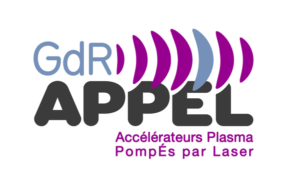Orateur
Description
Proton-Boron nuclear reactions have been actively studied these last few years as a possible
way of producing secondary alpha particles sources. Proton acceleration by interaction of ultra-high
intense lasers with hydrogenated targets is the preferred way to initiate those type of reactions. [1]
The alpha particles sources are studied for production of radio-isotopes as medical applications to
be able to achieve an effective alternative to cyclotrons classically used.
The two main mechanisms of ion acceleration studied for this nuclear scheme are the Target
Normal Sheath Acceleration (TNSA) and the Hole-Boring (HB) process. In the first case, protons
are accelerated at the rear side of the target via the electrostatic field induced by laser driven electrons escaping from the target. The exponential shape of the proton energy spectrum induces a
great number of nuclear reactions throughout a Boron secondary target despite a decrease of the
cross-section above the main resonance at 675 keV.
For the Hole-Boring process, ions are accelerated at the front side thanks to the electric field
induced by the electrons pushed by the radiation pressure of these high laser intensities. Accelerated
protons interact directly with boron atoms contained within the same target [2]. Different types of targets have been studied both numerically and experimentally for Hole-Boring based alpha production.
Particle-in-Cell (PIC) and Monte-Carlo simulations have been conducted to better
understand experimental campaigns done on the VEGA-III laser at CLPU, Salamanca, Spain in
november 2022 and march 2023. This laser is characterized by a short pulse duration, 30fs and a
high-repetition rate of 1Hz. The two ion acceleration schemes have been studied numerically to better understand the experimental data and to further the analysis. Angular analysis of particle bunches (protons, carbon ions and alpha) has been done to support experimental results obtained on CR-39 track diagnostics. Simulations have thus allowed to discriminate traces found on these diagnostics and given confidence on the number of alpha particles obtained.
[1] Margarone Daniele, Alessio Morace, Julien Bonvalet, Yuki Abe, Vasiliki Kantarelou, Didier
Raffestin, Lorenzo Giuffrida, et al. « Generation of α-Particle Beams With a Multi-KJ, Peta-Watt
Class Laser System ». Frontiers in Physics 8 (9 septembre 2020): 343.
https://doi.org/10.3389/fphy.2020.00343.
[2] Margarone, Daniele, Julien Bonvalet, Lorenzo Giuffrida, Alessio Morace, Vasiliki Kantarelou,
Marco Tosca, Didier Raffestin, et al. « In-Target Proton–Boron Nuclear Fusion Using a PW-Class
Laser ». Applied Sciences 12, no 3 (28 janvier 2022): 1444. https://doi.org/10.3390/app12031444.



